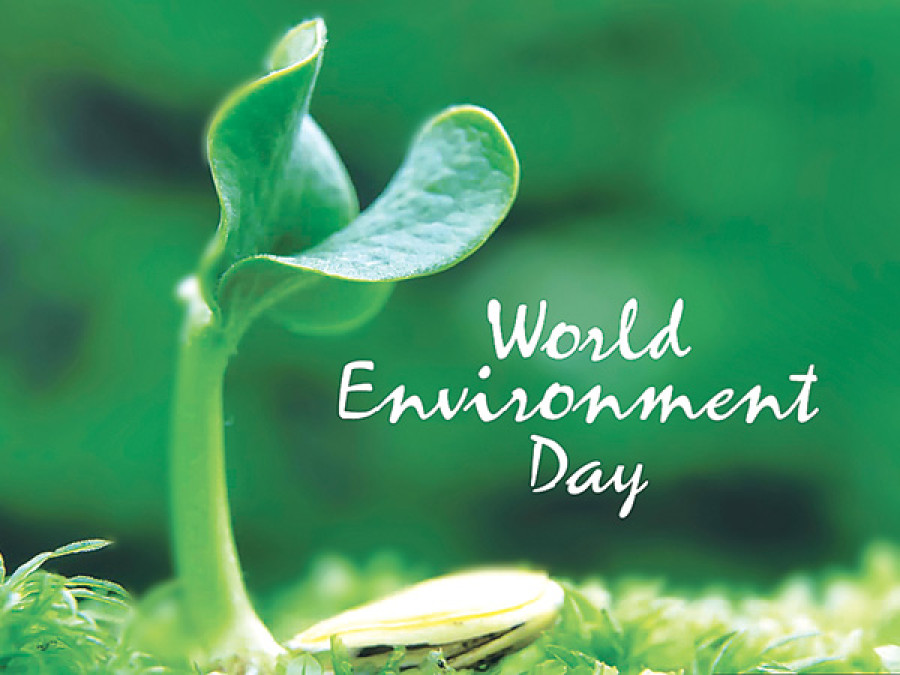Opinion
Get involved
We need to do more than wave placards and hold rallies on World Environment Day
Sramika Rijal
World leaders from 113 countries came together in Stockholm, Sweden on June 5, 1972 to think about our planet’s future after the impacts of human activities on the environment started being noticed. Since then, the anniversary of the Stockholm Conference has been celebrated as World Environment Day (WED). The theme of WED 2016 is ‘Go Wild for Life: Zero Tolerance for the Illegal Wildlife Trade’. Every individual should help safeguard threatened species for future generations. We need to change our habits and attitude so that the illegal trade in valuable plants and wildlife products decreases and awareness about biodiversity conservation increases.
In the past, WED used to be an important day in the calendar of the United Nations; but in recent years, we can see people holding different activities to mark the day throughout the world including in Nepal. Youths, leaders, development workers, researchers and university and school students are also being encouraged to participate in these activities. Since people’s livelihoods are directly related to environmental conservation and management, and WED has become the biggest day for positive environmental action, there is much more that can be done to celebrate it in a sustainable way.
The government has exhibited commitment to the conservation of the different aspects of the environment. Nepal has signed many international conventions and treaties related to environmental conservation like the Ramsar Convention on Wetlands and the Convention on International Trade in Endangered Species of Wild Fauna and Flora (CITES) besides passing legislation like the National Park and Wildlife Conservation Act, Forest Act and Environment Protection Act. Yet, the celebration of WED in Nepal is limited to activities like holding street rallies, waving environmental awareness placards and organising tree plantation programmes, essay writing contests, poster competitions, cleanup campaigns and art exhibitions. The question is whether these events are enough to achieve sustainable development. Environmentalists, conservationists and government officials need to ponder this issue and implement programmes that lead to a sustainable future.
In order to achieve sustainable development, WED should not be confined to awareness campaigns. It needs to encompass field-based activities and knowledge sharing and technology dissemination programmes in every corner of the country by mobilizing a plethora of competent human resources. The celebration will be more fruitful if people’s participation at the local level is high. It should have specific objectives like achieving zero emission, adopting organic agriculture, promoting bio-fertilizers and bio-pesticides and replacing chemical farm inputs, holding habitat management activities in protected areas and making efforts related to species conservation. These activities will ultimately result in a green economy. Thus, this might be the right time for Nepal to accept and implement a green economy which reduces environmental risks and creates a balanced ecology.
Conservationists have managed human-wildlife conflicts by promoting wise alternatives like planting unpalatable crops on farmlands instead of killing or hurting the animals that come to plunder them. Further, following safe trapping methods and translocating animals like the swamp deer and the one-horned rhino from one protected area to another seems to be an effective approach.
However, proper habitat improvement and management practices are required. Invasive plant species like Parthenium hysterophorus (an aggressive weed) and Mikania macrantha (mile-a-minute weed) have affected habitats to a wide extent in protected areas. Not only terrestrial but also aquatic life suffers from such deleterious weeds. So, the removal of these species is necessary in today’s context. Further, the earthquake of 2015 created havoc with huge habitat fragmentation leading to a loss of species wealth. The diversity of flora and fauna became affected in many parts of the country. So the concept of safe wildlife corridors should be put forward.
The impacts of climate change on agriculture and forestry are visible in our country. People are adopting strategies like off-season cultivation, rain water harvesting, community seed banks and organic agriculture that leads to climate smart agriculture (CSA). In this context, nationwide campaigns on adopting such practices can be conducted as part of the celebration of WED throughout the year.
It is undoubtedly a matter of pride that Nepal has gained attention because of its efforts in conserving biodiversity, especially wildlife like the rhino and the tiger. It has also celebrated zero poaching years. However, there still remain major issues like climate change, massive use of chemical pesticides and fertilizers, rapid urbanisation and change in land use patterns which have added more challenges in the field of conservation. To tackle these challenges, it is of utmost importance to have the active participation of youths, women, children, indigenous communities, local authorities, business communities, trade unions, organizations and other stakeholders. Furthermore, the active involvement of the public and private sectors has been recognised as being essential to achieve a sustainable environment.
Rijal is an assistant professor at Agriculture and Forestry University, Chitwan




 10.12°C Kathmandu
10.12°C Kathmandu










